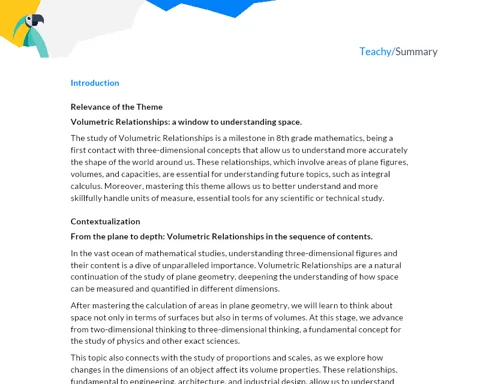Factoring by Difference of Squares: Simplifying Complex Problems
Objectives
1. Understand the concept of difference of squares and its formula a² - b² = (a + b)(a - b).
2. Apply the difference of squares formula to factor algebraic expressions.
3. Identify practical situations where factoring by difference of squares can be used.
Contextualization
Factoring by difference of squares is a mathematical technique that allows for the simplification of complex algebraic expressions. For example, consider the construction of a bridge where it is necessary to optimize weight distribution to ensure the structure's strength. Factoring expressions can help transform complicated calculations into more manageable forms, facilitating the resolution of practical problems. Another application can be found in data science, where resource optimization algorithms use this technique to improve process efficiency.
Relevance of the Theme
Mastering factoring by difference of squares is crucial in today's context, as it allows for the simplification of complex problems in various areas, such as engineering, data science, and economics. This mathematical skill not only enhances problem-solving abilities but also prepares students for future challenges in the job market, where resource optimization and informed decision-making are essential.
Concept of Difference of Squares
The difference of squares is a factoring technique based on the algebraic identity a² - b² = (a + b)(a - b). This identity allows us to transform the subtraction of two perfect squares into a product of binomials, simplifying the algebraic expression.
-
Formula: a² - b² = (a + b)(a - b)
-
Transforms subtraction of perfect squares into a product of binomials
-
Facilitates the resolution of complex algebraic expressions
Application of the Difference of Squares Formula
The application of the difference of squares formula involves identifying expressions that can be factored using the identity a² - b² = (a + b)(a - b). This technique is useful for simplifying calculations and solving equations more efficiently.
-
Identification of expressions that can be factored
-
Simplification of algebraic calculations
-
Efficient resolution of equations
Practical Applications of the Difference of Squares
The difference of squares has various practical applications in fields such as engineering, data science, and economics. For example, it can be used to optimize engineering structures, improve data processing algorithms, and simplify economic analyses.
-
Optimization of engineering structures
-
Improvement of data processing algorithms
-
Simplification of economic analyses
Practical Applications
- In civil engineering, the difference of squares can be used to optimize the design of bridges and other structures, ensuring more efficient weight distribution.
- In data science, this technique can be applied to improve machine learning algorithms, optimizing the allocation of computational resources.
- In economics, factoring by difference of squares can simplify variance and deviation analysis, helping to predict market trends and make informed decisions.
Key Terms
-
Difference of Squares: A factoring technique based on the identity a² - b² = (a + b)(a - b).
-
Factoring: The process of decomposing an algebraic expression into a product of simpler factors.
-
Binomials: Algebraic expressions that consist of the sum or subtraction of two terms.
Questions
-
How can factoring by difference of squares be applied in everyday situations?
-
What challenges might you encounter when using the difference of squares in practical problems?
-
In what ways can understanding the difference of squares benefit your future professional careers?
Conclusion
To Reflect
Factoring by difference of squares is a powerful mathematical tool that goes beyond the classroom. Understanding and applying this technique allows for the simplification of complex algebraic expressions, transforming seemingly difficult problems into more manageable forms. This skill is extremely useful in various fields, from engineering, where it optimizes weight distribution and structure strength, to data science and economics, where it improves the efficiency of algorithms and simplifies complex analyses. By mastering the difference of squares, you not only enhance your mathematical skills but also prepare to tackle real-world challenges in the job market, where the ability to solve problems and optimize resources is essential.
Mini Challenge - Practical Challenge: Optimizing Structure Construction
In this mini-challenge, you will apply the technique of factoring by difference of squares to optimize the construction of a structure using simple materials.
- Form groups of 4 to 5 students.
- Use materials such as popsicle sticks, glue, and rubber bands to construct a bridge.
- Sketch a design of the bridge, identifying where the difference of squares will be applied to optimize strength and distribute weight efficiently.
- Build the bridge following the sketch.
- Test the bridge's strength by gradually adding weights until the structure fails.
- Record the results of different strategies and discuss which were more effective and why.



